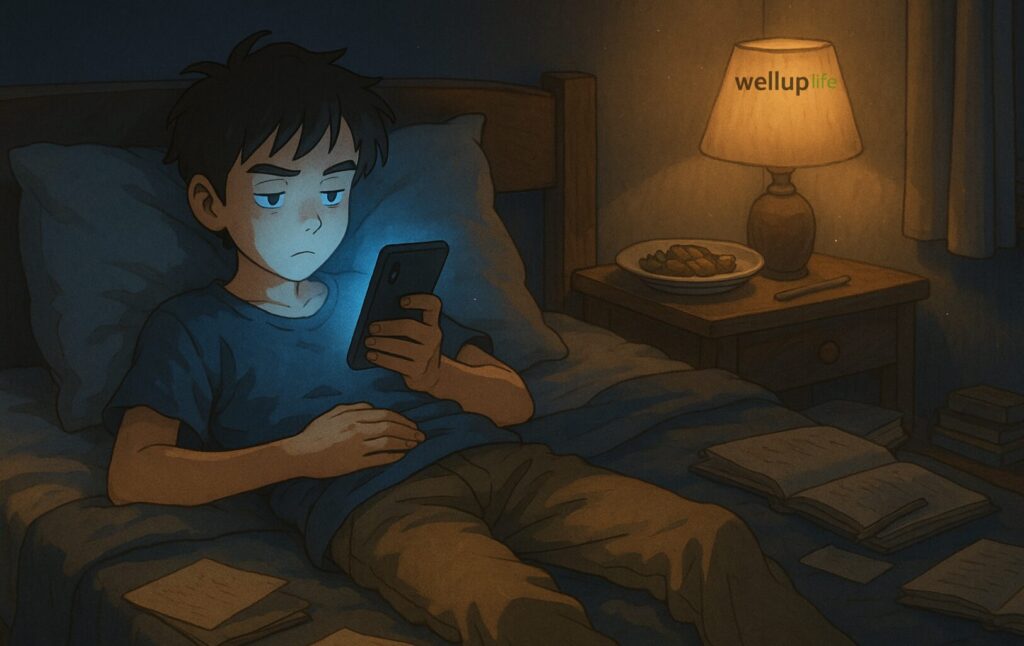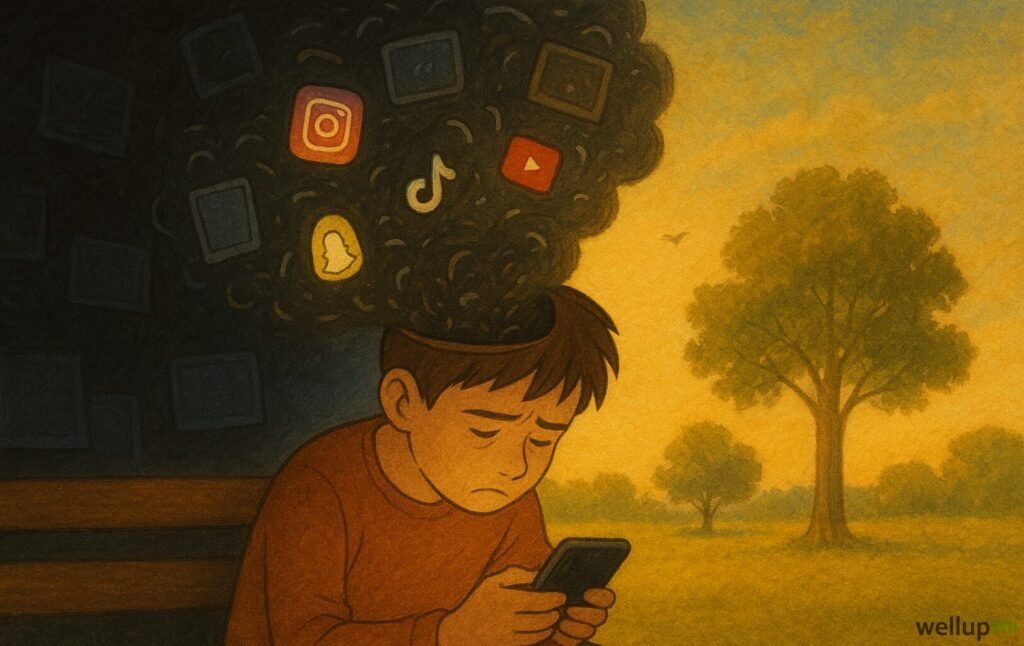Do you reach for your phone the moment you wake up? If you do so, then you’re not alone. In fact, the average person taps, swipes, or clicks their phone over 2,600 times a day [1]Dscout Research.
While smartphones are powerful tools, they’ve slowly taken control of our attention, emotions, and even sleep cycles. From doomscrolling late into the night to checking notifications every few minutes, we’re caught in a loop that feels almost impossible to escape.
This isn’t just about screen time—it’s about mental well-being, productivity, and peace of mind. Studies have linked excessive smartphone use to higher stress levels, poor sleep, and reduced attention spans [2]Study published in Frontiers in Psychiatry.
But here’s the good news: you don’t need to give up your phone completely to reclaim control. With small, intentional steps taken daily, you can rewire your relationship with your device—and your mind.
Here is a 7-day action plan that will guide you step-by-step on how you get rid of your cell phone addiction. This isn’t just another detox. It’s a mindful system to help you:
- Recognize your digital habits,
- Set healthy boundaries,
- And build a balanced life, without quitting tech altogether.
So let’s begin the reset.
Your mind—and your time—deserve it.
What Is Phone Addiction?
Phone addiction—also known as nomophobia (short for no-mobile-phone phobia)—is a behavioral addiction characterized by excessive or compulsive use of smartphones, often at the expense of real-life relationships, responsibilities, and well-being.
It typically involves:
- Constant checking of the phone, even without notifications
- Anxiety or irritability when the phone is not accessible. Studies show that nomophobia can trigger anxiety levels similar to those seen in some clinical conditions [3]Study in Journal of Family Medicine and Primary Care.
- Difficulty staying focused without digital stimulation
- Prioritizing screen time over sleep, work, or social interaction
Psychologists classify smartphone addiction as a subtype of internet addiction disorder, where the user feels psychologically dependent on their device to cope with boredom, loneliness, or stress [4]Journal of Behavioral Addictions.
While it’s not formally recognized in the DSM-5 (Diagnostic and Statistical Manual of Mental Disorders), its symptoms often mirror other behavioral addictions in terms of impulse control, withdrawal, and reward-seeking behavior.
In short, Phone addiction is the excessive and compulsive use of a smartphone that disrupts daily life, reduces productivity, and negatively impacts mental, emotional, or physical well-being.
Common Symptoms of Phone Addiction
Recognizing the signs of phone addiction is the first step to taking back control of your time and attention. While it’s normal to occasionally spend extra time on your phone—whether for work, entertainment, or staying connected—true phone addiction goes beyond that. It develops into a persistent habit where checking your phone becomes automatic, constant, and often unnecessary.
This overuse can begin to interfere with your productivity, relationships, sleep quality, and mental health. You may find yourself reaching for your phone without thinking, feeling anxious when it’s not nearby, or struggling to focus on tasks without interruptions from notifications.
To help you assess your own habits, here are some of the most common symptoms of phone addiction that you can consider:
1. Behavioral Symptoms
- Feeling the urge to check your phone constantly, even without notifications
- Opening apps mindlessly out of habit, not necessity
- Spending several hours daily on the phone, often without realizing it
- Losing track of time while scrolling through apps or social media
- Constantly checking for signal, battery, or Wi-Fi
- Using the phone late at night or right before bed
- Skipping social events or interactions to be online
- Choosing phone use over hobbies, physical activity, or personal goals
- Using a phone while driving or walking

2. Emotional & Psychological Symptoms
- Increased anxiety and stress due to constant notifications and online comparison
- Higher risk of depression and low self-esteem from social media overuse
- Feeling anxious, restless, or irritated when the phone is out of reach
- Feeling anxious, low, or frustrated when not using the phone
- Using the phone to escape boredom, stress, or emotional discomfort
3. Cognitive & Mental Health Symptoms
- Difficulty focusing or maintaining attention on tasks (digital brain fatigue)
- Difficulty concentrating on tasks without checking the phone
- Frequent multitasking or task-switching due to constant notifications
4. Physical & Social Impact
- Eye strain or headaches
- Text neck (pain in the neck or shoulders from poor posture)
- Finger or wrist pain from excessive scrolling or typing
- Poor sleep quality due to blue light exposure and mental stimulation
- Less quality time with family and friends
- Emotional distance caused by prioritizing phone use over in-person conversations
You can even include a mini self-question to assess yourself:
- Do you feel anxious when you can’t check your phone?
- Is your screen time affecting your sleep or productivity?
- Have friends or family commented on your phone use?
If you answered yes to 2 or more, this 7-day reset plan is made for you.
Step-By-Step 7-Day Plan To Get Rid Of Smartphone Addiction
Smartphone addiction can slowly take away your time, focus, and energy. This 7-day smartphone detox plan will help you break phone addiction in a simple and mindful way, without suddenly giving up your phone. Each day gives you easy steps to reduce screen time, replace bad phone habits, and build a healthy digital lifestyle. Follow this 7-day plan to improve focus, boost mental health, and enjoy life beyond the screen.
Day 1: Awareness & Self-Assessment
The first step to breaking any addiction or habit is understanding it. Today is all about observing, not changing anything. Identify yourself how, when, and why you use your phone.
What to Do Today:
1. Track Your Screen Time
- Use built-in Apps like:
- Digital Wellbeing (Android)
- Screen Time (iOS)
- Look at:
- What is your total screen time
- Which apps are you using most?
- What is the number of unlocks and pickups?
You’ll be surprised how often you reach for your phone without any real reason.
2. Identify Your Triggers
- Ask yourself:
- When do I usually reach for my phone?
- What am I trying to avoid or feel when I do it?
- Common triggers: boredom, stress, waiting, emotional discomfort
3. Journal or Reflect
Write down answers to these:
- Which 3 apps do I spend the most time on?
- What time of day is my usage highest?
- How do I feel before and after using my phone?
What gets measured, gets managed.
Awareness is the first step — when you understand your habits and triggers, you can take mindful action to overcome phone addiction.
Day 2: Declutter Your Digital Space
Now that you’ve audited your habits, it’s time to clean up your digital environment. Just like a cluttered room leads to stress, a cluttered phone encourages mindless scrolling and distraction.
What to Do Today:
1. Delete or Disable Distracting Apps
- Remove apps you rarely use or mindlessly scroll through (like social media, shopping apps, or news feeds).
- Ask yourself: Does this app serve me, or steal my attention?
Tip: You can always reinstall later—but most likely, you won’t miss it.

2. Turn Off Non-Essential Notifications
- Go to your settings and disable notifications for:
- Social media
- Shopping apps
- News alerts
- Keep notifications only for essential tools (e.g., calls, calendar, banking).
Studies show that frequent phone notifications can disrupt focus
and trigger stress [5]Study in Computers in Human Behavior.
3. Move Tempting Apps Off the Home Screen
- Relocate distracting apps to a hidden folder or a second screen.
- Keep only utility apps (contacts, call, calendar) on your home screen.
4. Declutter Your Home Screen Aesthetically
- Use a calming wallpaper.
- Use a minimalist theme for fewer distractions.
- Keep only 4–6 essential apps visible.
- Organize remaining apps by category, or use the search bar instead of icons.
Remember the thing which is out of sight is out of mind.
Less visual clutter = fewer triggers = more mental clarity.
Day 3: Set Phone-Free Zones
You’ve decluttered your digital space — now it’s time to create physical boundaries. Just like we have rooms for sleeping, eating, or studying, your phone should have designated no-entry zones.
What to Do Today:
1. Choose 3-4 Phone-Free Zones in Your Day
One of the easiest ways to reduce phone addiction is to create “phone-free zones” — specific places or times where your phone is simply not allowed. This removes temptation and helps you be more present in the moment.
Start with:
- Bedroom – Keeping your phone out of your bedroom improves sleep quality by reducing blue light exposure and mental stimulation before bed. You’ll also avoid the endless “just one more scroll” trap.
- Study room – A phone-free study space helps you stay focused and enter deep work mode without constant pings or the urge to check apps.
- Dining table – Meals are a time to nourish both your body and relationships. Keeping your phone away encourages mindful eating and better conversations.
- Bathroom – Many people habitually scroll in the bathroom, which extends screen time unnecessarily and creates a constant dependency. So next time, when you go to the bathroom, be conscious of whether you are carrying your phone with you or not.
Create small visual cues like a sticky note or a reminder: “This space is for presence, not phones.”

2. Use a “Phone Parking Spot”
Designate a fixed place to keep your phone—like a drawer, desk tray, or separate room—during:
- Work or study time
- Meals
- Family/friend time
This physical boundary makes it easier to disconnect without relying on willpower.
3. Buy (or Use) an Alarm Clock
- Keep your phone outside your bedroom.
- Replace it with an old-fashioned alarm clock.
- This alone can improve your sleep quality dramatically [6]Harvard Health Publishing.
Your environment shapes your behavior more than your intentions.
Design your space to support presence over distraction. By setting just 3–4 phone-free zones, you create natural breaks from your device, making it easier to retrain your brain and form healthier habits.
Day 4: Replace the Habit
By now, you’ve become aware of your patterns, cleaned up your digital space, and created physical boundaries. Today’s focus is replacing the habit, because breaking a habit without replacing it creates a void that pulls you right back.
We don’t just eliminate habits—we replace them with better ones.
What to Do Today:
1. Identify Your “Trigger Moments”
Look at your Day 1 journal. Ask:
- When do I feel the urge to check my phone?
- What feeling or situation triggers that urge?
Common triggers:
- Boredom while waiting
- Stress or emotional discomfort
- Seeking validation or stimulation
- Habitual checking during downtime
2. Create a “Habit Swap” List
Match each trigger with a healthier, offline action.
| Trigger | New Habit (Swap) |
|---|---|
| Waiting in line | Observe surroundings / Deep breathing |
| Feeling stressed | Short walk / Stretching / Sipping tea |
| Bored at home | Read self-help books / Listen to music |
| Lonely / emotional | Call a friend / Journal your feelings |
| Habitual scrolling | Do 5 push-ups / Mindful breathing for 1 min |
Habit swap isn’t about perfection—it’s about pausing, interrupting, and redirecting your energy.

3. Start a New Offline Hobby or Ritual
Pick one small activity you can do daily instead of scrolling. Here are some small activities that you can do.
- Spend five minutes journaling to clear your mind and reflect on your thoughts.
- Engage in drawing or doodling to spark creativity and relax your mind.
- Play a musical instrument to enjoy a mindful, screen-free activity.
- Water your plants and connect with nature, even in small ways.
- Do some stretching or yoga to release tension and refresh your body.
- Spend quality time with friends to strengthen social bonds and enjoy face-to-face conversations.
Your brain craves novelty—feed it real-life richness, not digital noise.
You can’t break a habit unless you build a new one in its place.
Replacing the quick dopamine rush you get from mindless scrolling with meaningful, intentional rituals—such as creative hobbies, physical activity, or genuine social connection—rewires your brain for healthier rewards, helping you build lasting habits that bring real fulfillment instead of temporary distraction.
Day 5: Schedule Phone Use
By now, you’ve reduced clutter, created boundaries, and found healthier alternatives. Today’s step is about taking full control of when you use your phone—so your device fits into your life, not the other way around.
Most people check their phones impulsively hundreds of times a day. But when you designate fixed check-in times, you break that constant pull and gain hours of extra focus.
What to Do Today:
1. Set 2–3 “Phone Check-In” Times
Decide in advance when you’ll use your phone for non-essential purposes (social media, messages, browsing).
- Example schedule:
- 1:00 PM – Social check-in & reply to messages
- 6:00 PM – Evening updates and casual browsing
- Outside of these windows, keep your phone in your “parking spot” (from Day 3).
This prevents constant interruptions and allows you to be more present in between.
2. Use App Timers or Digital Wellbeing Tools
Most phones now have built-in time limits:
- Android: Digital Wellbeing → App Timers
- iOS: Screen Time → App Limits
- Set daily usage caps for time-wasting apps (e.g., 30 minutes max per day).
3. Batch Notifications
- Turn off instant alerts and check them only during your scheduled windows.
- This mimics the productivity principle of batching tasks—handling similar activities at once to save mental energy.
4. Anchor Phone Use to Existing Routines
Link phone time to habits you already have:
- After lunch → 20 min phone check-in
- After evening workout → 15 min casual browsing
Anchoring makes it easier to remember while keeping it under control.
5. Create a Phone Use “Curfew”
- Stop phone use 1–2 hours before bedtime to protect your sleep quality.
- Instead, wind down with reading, meditation, or stretching.
Research shows that blue light and mental stimulation from screens can delay sleep and reduce melatonin production [7]Harvard Medical School.
Pro Tip: Use “Do Not Disturb” Mode
Set your phone to DND outside check-in windows, but allow calls from important contacts.
If you don’t set boundaries for your phone, it will set boundaries for your life.
When you control your phone time, you gain time for life itself.
Day 6: Digital Detox Evening
The hours before bedtime are critical for your mental health, focus, and sleep quality. Yet, for most people, they’ve become prime scrolling hours—social media, late-night YouTube binges, or endless “just one more” notifications.
Tonight’s mission: Create a calm, phone-free evening routine that allows your brain to slow down, your body to relax, and your sleep to improve.
Why an Evening Detox Matters
- Blue light from screens suppresses melatonin, making it harder to fall asleep [6]Harvard Health Publishing.
- Stimulating content (news, social media, games) keeps your brain in alert mode when it should be winding down.
- Late-night scrolling can delay bedtime, leading to less restorative sleep and groggy mornings.
What to Do Today:
1. Set a Digital Curfew
- Choose a cut-off time (e.g., 8:00 PM or 1–2 hours before bed).
- Commit to zero social media, texting, or browsing after this time.
- Put your phone in your parking spot from Day 3.
2. Replace Scrolling with a Wind-Down Ritual
Pick 2–3 calming offline activities to do after your curfew:
- Reading a physical book or magazine
- Light stretching or yoga
- Journaling about your day
- Listening to soft music or a podcast (on a non-phone device if possible)
- Preparing herbal tea
3. Use “Night Mode” Before Your Curfew
- Turn on Night Shift (iOS) or Blue Light Filter (Android) a couple of hours before your cut-off time.
- This reduces blue light exposure in case you need to glance at your phone.
4. Charge Your Phone Outside the Bedroom
- Keep it in another room overnight.
- Use a real alarm clock to avoid “alarm + instant scroll” mornings.
5. Reflect on the Difference
Before bed, jot down:
- How does your mind feel without screens tonight
- Whether you fall asleep faster
- Your mood compared to the previous night
“The way you end your day determines how you start the next one.”

A phone-free evening isn’t just about sleep—it’s about creating mental space for rest, reflection, and creativity.
Day 7: Reflect & Redesign
Great! You’ve made it to the final day!
Over the past week, you’ve taken intentional steps—tracking your habits, decluttering, setting boundaries, replacing old patterns, scheduling usage, and detoxing your evenings.
Today’s mission: Look back at your journey, celebrate progress, and design a long-term plan to keep your phone habits in check.
Step 1: Review Your Progress
Pull out your notes from Day 1’s Awareness & Self-Assessment:
- Compare your screen time from Day 1 to Day 7
- Notice changes in:
- Time spent on distracting apps
- Sleep quality
- Focus and productivity
- Mood and stress levels
Even small improvements matter—progress compounds over time.
Step 2: Identify What Worked
Ask yourself:
- Which habits were easiest to stick to?
- Which were the hardest?
- What gave you the biggest positive impact?
Mark these as your core habits to continue.
Step 3: Address What Didn’t Work
- Did you struggle with evening detox? Maybe shorten the cut-off time gradually.
- Couldn’t stick to 2–3 phone check-in windows? Try increasing them slightly until it feels comfortable.
The goal isn’t perfection—it’s sustainable control.
Step 4: Design Your Long-Term “Phone Policy”
Write your own Phone Use Rules:
- Maximum daily screen time
- Phone-free zones in your home
- Digital detox evening cut-off time
- Weekly no-phone activity (e.g., hike, family dinner, creative hobby)
Keep this policy visible—stick it on your desk, wall, or journal for a daily reminder.
Step 5: Commit to Regular Digital Check-Ins
- Do a monthly screen time review
- Every 3 months, take a 24-hour full digital detox
- Revisit your phone boundaries whenever life changes
“Your phone is a tool, not a timeline. Make it work for you, not against you.”
The goal isn’t to banish your phone—it’s to use it with purpose and protect your attention for what truly matters.
End-of-Week Reflection Prompt
How do I feel after 7 days of intentional phone use?
What have I gained?
What am I determined to keep doing from now on?
Takeaways
Breaking free from smartphone addiction doesn’t mean abandoning technology—it’s about reclaiming control over your attention, time, and energy. This 7-day plan works because it begins with awareness, helping you track your screen time and identify triggers that fuel mindless scrolling.
Once you see the full picture, small changes—like decluttering your digital space, creating phone-free zones, and scheduling intentional phone use—start to make a big difference. The key isn’t just removing phone time, but replacing it with meaningful activities such as reading, exercising, meditating, or spending time with loved ones, ensuring lasting transformation.
Setting clear boundaries, like no-phone mornings or evening digital detoxes, creates the mental space you need for focus, reduced anxiety, and better sleep. Finally, regular reflection helps you fine-tune your habits and settings so you remain in control over the long term.
The goal isn’t simply to cut screen time—it’s to live more intentionally and reclaim the moments your phone has been quietly stealing.
If you found this helpful? Please share with your friends who need it the most, and subscribe to our newsletter and get a printable 7-day phone detox tracker!





 — Peter Drucker
— Peter Drucker — James Clear, Atomic Habits
— James Clear, Atomic Habits — Charles Duhigg, The Power of Habit
— Charles Duhigg, The Power of Habit

 — Unknown
— Unknown




